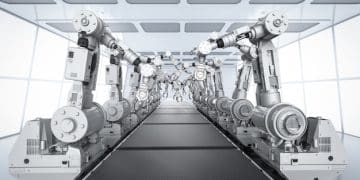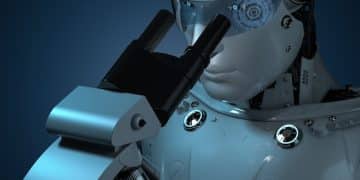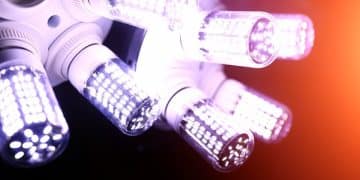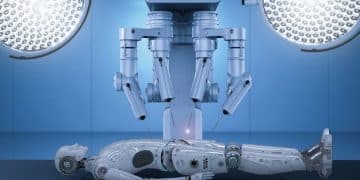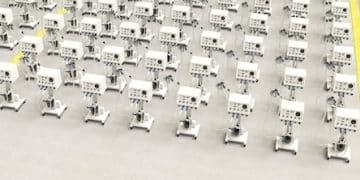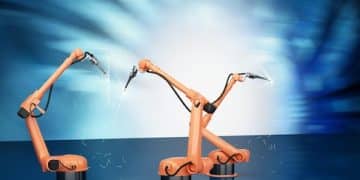US Robotics and AI: Enhancing Robot Capabilities

The integration of artificial intelligence (AI) is fundamentally transforming US robotics, enhancing robot capabilities across various sectors by enabling advanced perception, decision-making, and autonomous operation crucial for complex tasks and real-world applications.
In the rapidly evolving landscape of technology, the synergy between US robotics and Artificial Intelligence: How AI is Enhancing Robot Capabilities represents a monumental leap forward. This powerful convergence is not merely an incremental improvement but a fundamental reshaping of what robots can achieve, promising to unlock unprecedented levels of precision, autonomy, and adaptability in diverse applications.
the foundational synergy: AI and robotics
The relationship between artificial intelligence and robotics is symbiotic; AI provides the cognitive abilities, while robots offer the physical embodiment to act upon those insights. In the burgeoning US robotics sector, this partnership is particularly vital. AI algorithms allow robots to perceive their environment, understand complex instructions, and make intelligent decisions autonomously, moving beyond pre-programmed movements to genuinely adaptive behaviors.
This integration is creating robots that are not just tools but intelligent partners, capable of learning from experience and adapting to dynamic situations. They can identify patterns, predict outcomes, and optimize their actions in ways that were previously unimaginable. This shift is critical for deploying robots in unstructured and unpredictable environments, such as those found in manufacturing, logistics, or even medical settings.
evolving beyond automation: the intelligence factor
While traditional robots excelled at repetitive, precise tasks within controlled environments, AI confers a new dimension: intelligence. This intelligence allows robots to handle variability, uncertainty, and unexpected events, moving them from mere automation to true autonomy.
- Enhanced Perception: AI-powered computer vision and sensor fusion allow robots to interpret visual and sensory data with unparalleled accuracy, distinguishing objects, understanding scenes, and navigating complex spaces effectively.
- Cognitive Decision-Making: Machine learning algorithms enable robots to process vast amounts of data, identify optimal strategies, and resolve complex problems in real-time, making decisions on the fly.
- Adaptive Learning: Robots can continuously learn from new data and experiences, refining their performance over time and adapting to changes in their environment or tasks.
This deep integration means that robots can now perform intricate assembly tasks, navigate warehouses filled with obstacles, assist in delicate surgical procedures, or even interact more naturally with humans. The ability to learn and adapt is what truly distinguishes AI-enhanced robots from their predecessors, marking a new era of robotic capability.
The continuous development of more sophisticated AI models, coupled with advancements in robotic hardware, fuels this rapid progression. The US, with its strong research institutions and tech industries, is at the forefront of exploring these frontiers, pushing the boundaries of what autonomous systems can achieve. This foundational synergy is not just about making robots smarter; it’s about making them more capable, reliable, and ultimately, more valuable across a spectrum of industries.
In essence, AI serves as the brain for the robotic body, providing the necessary intelligence for perception, reasoning, and action. This allows robots to transition from rigid machines to flexible, intelligent agents that can operate effectively in dynamic, real-world scenarios. The future of robotics is intrinsically linked to the advancements in artificial intelligence, promising an array of innovative applications.
AI-driven perception and navigation breakthroughs in robotics
One of the most significant ways AI enhances robot capabilities is through advancements in perception and navigation. For a robot to operate effectively in complex environments, it must first be able to ‘see’ and ‘understand’ its surroundings, and then navigate through them safely and efficiently. AI, particularly deep learning and computer vision, provides the sophisticated tools necessary for these tasks.
Traditional robotic systems relied on pre-programmed maps or simple obstacle avoidance. AI-driven approaches, however, enable real-time mapping, object recognition, and intelligent path planning, even in previously unseen or changing environments. This is a game-changer for applications ranging from autonomous vehicles to industrial robots and service robots.
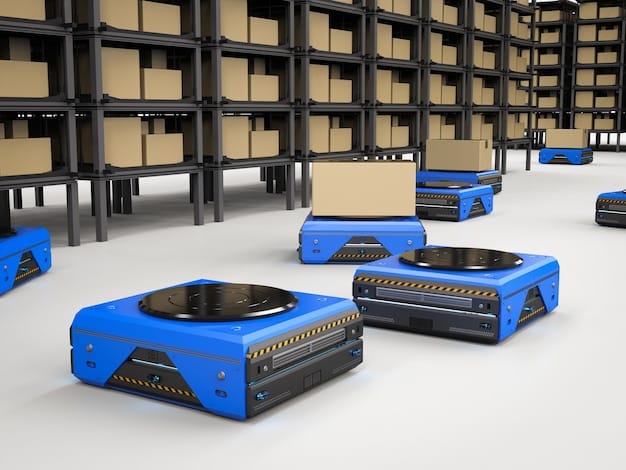
advanced computer vision and sensor fusion
Computer vision, powered by AI, allows robots to interpret visual data from cameras with human-like accuracy, or even superior in certain contexts. They can identify objects, distinguish between textures, recognize faces, and even understand human gestures. This is crucial for tasks requiring fine manipulation or interaction with people.
- Object Recognition and Classification: Robots can accurately identify and categorize various objects, vital for pick-and-place operations in manufacturing or sorting in logistics.
- Semantic Understanding: Beyond mere identification, AI enables robots to understand the context and purpose of objects within a scene, allowing for more intelligent interaction.
- Depth Perception and 3D Mapping: Using lidar, radar, and stereoscopic cameras, AI algorithms construct detailed 3D maps of environments, essential for precise navigation and manipulation.
Sensor fusion takes this a step further by combining data from multiple sensor types (cameras, lidar, ultrasonic sensors) to create a more robust and comprehensive understanding of the environment. AI algorithms synthesize this disparate data, filtering out noise and providing a clearer, more reliable picture than any single sensor could offer. This multi-modal perception enhances environmental awareness, reducing the risk of collisions and improving operational accuracy.
intelligent path planning and obstacle avoidance
Once a robot can perceive its environment, AI becomes indispensable for intelligent navigation. Path planning algorithms, often leveraging reinforcement learning, enable robots to determine the most efficient and safest routes to their destination, accounting for dynamic obstacles and changing conditions.
Unlike rigid, pre-defined paths, AI-driven navigation allows robots to adapt on the fly. If an unexpected obstacle appears, the robot can rapidly re-plan its route without human intervention. This adaptability is critical for deploying robots in shared spaces, whether it’s an automated guided vehicle (AGV) in a factory or a delivery robot on a sidewalk. The ability to anticipate potential collisions and implement avoidance maneuvers swiftly makes these systems much safer and more effective in real-world scenarios.
These breakthroughs in perception and navigation represent the core enablers for many of the advanced robotic applications emerging today. Whether it’s a drone inspecting infrastructure, an autonomous agricultural robot tending to crops, or a surgical robot assisting in an operating room, AI’s ability to provide sophisticated visual and spatial understanding is paramount. The continued refinement of these AI capabilities will unlock even more complex and nuanced robotic interactions with their physical surroundings.
robot-human collaboration and interaction powered by AI
The vision of robots working seamlessly alongside humans, rather than merely replacing them, is rapidly becoming a reality, largely due to advancements in AI. Human-robot collaboration (HRC) moves beyond traditional robotics, where safety cages separated humans and machines. AI enables robots to understand human intent, predict human actions, and adapt their behavior to ensure both productivity and safety in shared workspaces.
This shift from isolation to integration is revolutionizing industries from manufacturing to healthcare and logistics, opening new avenues for efficiency and innovation. The emphasis is on complementary skills: robots handle repetitive or dangerous tasks, while humans provide cognitive flexibility, problem-solving, and emotional intelligence.
understanding human intent and gestures
For effective collaboration, robots need to understand their human counterparts. AI-powered computer vision and natural language processing (NLP) are key to achieving this. Robots can now interpret human gestures, facial expressions, and spoken commands, making interaction more intuitive and natural.
- Gesture Recognition: A robot can interpret a human’s pointing gesture to identify an object or a hand signal to stop or start an operation, mimicking human-to-human communication.
- Speech Recognition and NLP: Advanced AI allows robots to understand spoken instructions, answer questions, and even engage in basic conversations, simplifying operator commands.
- Intention Prediction: By analyzing human movements and contextual cues, AI can predict a human’s next action, enabling the robot to prepare for collaboration or avoid potential interference.
This ability to understand non-verbal and verbal cues makes robots invaluable partners, as they can anticipate needs and respond accordingly, improving workflow efficiency and reducing the need for explicit programming or commands. For example, a collaborative robot (cobot) on an assembly line can hand a specific component to a human worker simply by observing their gaze or hand movement.
adaptive safety and shared workspace awareness
Safety is paramount in HRC. AI algorithms are crucial for developing dynamic safety protocols that allow robots to operate in close proximity to humans without risk. This involves continuous monitoring of the shared environment and instant reaction to potential hazards.
Robots equipped with AI often use multiple sensors (cameras, lidar, force/torque sensors) to constantly scan their surroundings. If a human enters the robot’s workspace, the AI can detect their presence, slow down, re-route, or even stop instantly to prevent contact. This adaptive safety system contrasts sharply with older, static safety measures that required physical barriers.
Furthermore, AI facilitates shared awareness. Robots can learn about human workflow patterns, preferred working distances, and even individual human behaviors, optimizing their own movements to complement those of their human colleagues. This level of synchronization fosters a more harmonious and productive work environment. The ethical implications of ever-smarter robots are a focal point in US research, ensuring that trust and safety remain at the core of AI-enhanced human-robot interaction. This field promises not just safer factories, but also more effective assistive robots in healthcare and domestic settings, truly enhancing human capabilities rather than merely augmenting them.
AI and autonomous decision-making in robotic systems
The pinnacle of AI’s contribution to robotics lies in empowering autonomous decision-making. Beyond mere perception and navigation, AI enables robots to reason, plan, and execute tasks with minimal to no human intervention, a pivotal capability for operating in complex and unpredictable environments. This autonomy is revolutionizing sectors such as space exploration, disaster response, and logistics, where human access or continuous oversight is challenging or dangerous.
This involves sophisticated algorithms that allow robots to analyze situations, evaluate consequences of different actions, and choose the optimal path forward to achieve their goals, adapting as circumstances change.
real-time planning and adaptation
One of the core strengths of AI in autonomous decision-making is its capacity for real-time planning and adaptation. Traditional robots follow pre-defined sequences. Autonomous robots, however, can generate and adjust their plans dynamically based on new information or unexpected events.
- Dynamic Task Management: Robots can prioritize tasks, re-schedule operations, or even self-correct if a goal cannot be achieved through the initial plan due to unforeseen circumstances.
- Environmental Adaptability: If sensors detect a sudden change in the environment—a new obstacle, a changed work order, or equipment malfunction—the AI can rapidly formulate a new strategy.
- Predictive Maintenance: AI can analyze sensor data from the robot itself to predict potential failures, allowing for proactive maintenance and reducing downtime, thereby optimizing operational efficiency.
This level of adaptability is crucial for tasks performed in remote or hazardous locations, such as inspecting damaged nuclear facilities, exploring planetary surfaces, or conducting search and rescue operations in collapsed buildings. The robot makes intelligent decisions independently, ensuring mission success even when conditions are far from ideal.
reinforcement learning for optimal strategy
Reinforcement learning (RL) is a particularly powerful AI technique for fostering autonomous decision-making in robots. In RL, a robot learns to perform a task by trial and error, receiving rewards for desired actions and penalties for undesirable ones. Over time, it develops a policy (a set of rules) that maximizes its cumulative reward, leading to optimal strategies.
Unlike supervised learning, RL doesn’t require vast amounts of labeled data; instead, the robot actively explores its environment and learns from the consequences of its actions. This is invaluable for tasks where defining every possible scenario or optimal action beforehand is impossible. For instance, in complex manipulation tasks, an RL-driven robot can learn the most efficient way to grasp and orient an object, even if the object’s exact position or angle varies.
The applications extend beyond manipulation to complex negotiation scenarios, logistics optimization, and even robotic swarms that coordinate autonomously. As RL algorithms become more sophisticated and data-efficient, they are enabling robots to tackle increasingly complex and open-ended problems, pushing the boundaries of what autonomous systems can achieve. The US continues to invest heavily in RL research for robotics, recognizing its potential to unlock true robot autonomy and versatility in real-world scenarios.
AI in robotic manipulation and fine motor control
One of the most challenging aspects of robotics has always been manipulation – the ability to grasp, move, and precisely place objects. Human hands possess an extraordinary degree of dexterity and adaptability, which traditional robots have struggled to replicate. However, the integration of AI, particularly in areas like deep reinforcement learning and advanced sensory feedback, is revolutionizing robotic manipulation, bringing robots closer to human-level dexterity.
This newfound capability is transforming industries that require delicate handling, precise assembly, or adaptable grasping, such as electronics manufacturing, healthcare, and logistics. It enables robots to handle a wider variety of objects, even those with irregular shapes or fragile surfaces, with unprecedented accuracy and gentleness.
adapting to unknown object properties
A significant hurdle in robotic manipulation is the variability of objects. AI allows robots to overcome this by enabling them to adapt to previously unknown or varying object properties like shape, weight, texture, and frictional coefficients. This adaptability is critical for tasks in unstructured environments where specific object details may not be predefined.
- Vision-Based Grasping: AI-powered computer vision system analyze an object’s geometry and estimate its properties, guiding the robot to determine the optimal grasp point and force.
- Force and Torque Feedback: Robots equipped with AI-enhanced force sensors can detect subtle resistance or slippage during grasping, allowing them to adjust their grip in real-time to prevent damage or drops.
- Deformable Object Handling: AI is enabling robots to manipulate soft, flexible, or deformable objects (like fabric or food items) by predicting how they will respond to force and adjusting movements accordingly, a task previously almost exclusive to human hands.
This capability is particularly vital in industries like apparel manufacturing or food processing, where objects are inherently variable. Traditional rigid robots would either damage the object or fail to grasp it altogether. AI provides the intelligence for the robot to ‘feel’ and ‘see’ the object in a way that allows for nuanced, adaptive handling.
precision assembly and delicate handling
Beyond simple grasping, AI is also enhancing precision in complex assembly tasks and delicate handling operations. This often involves very fine motor control and the ability to work within extremely tight tolerances.
For example, in micro-assembly for electronics, robots can use AI-driven vision systems to accurately align and place tiny components onto circuit boards with sub-millimeter precision. AI algorithms continuously monitor the position and orientation of parts, making real-time adjustments to ensure perfect placement. In healthcare, AI-enhanced surgical robots can perform intricate procedures with a steadiness and precision that surpasses human capability, minimizing invasiveness and improving patient outcomes.
The learning capabilities of AI, often through imitation learning or reinforcement learning, further refine these skills. Robots can learn from human demonstrations of a task or practice complex maneuvers in simulated environments, transferring that learning to the physical world. This iterative learning process allows robots to continuously improve their manipulation and fine motor control, promising a future where robots can perform an even broader range of dextrous tasks, pushing the boundaries of what is mechanically possible. The US is a hotbed for research in this domain, driving innovation in both hardware and AI algorithms for advanced robotic manipulation.
US robotics and AI in specific industry transformations
The integration of AI into US robotics is not merely an academic exercise; it’s a transformative force reshaping key industries. From manufacturing floors to hospital operating rooms and remote agricultural fields, AI-enhanced robots are driving new levels of efficiency, safety, and capability. This section explores how these advancements are translating into tangible benefits across diverse sectors.
The versatility of AI allows robots to adapt to the specific demands of varying industries, solving long-standing challenges and creating new opportunities for growth and innovation.
manufacturing and logistics: efficiency reimagined
Manufacturing and logistics were early adopters of robotics, but AI is pushing these sectors into an era of unprecedented efficiency and flexibility. Traditional industrial robots were largely pre-programmed and rigid; AI changes this by enabling adaptive manufacturing and intelligent logistics.
- Adaptive Production Lines: AI allows robots to adapt to changes in product design or production sequences without extensive re-tooling, enabling agile manufacturing and mass customization.
- Smart Warehousing: Autonomous mobile robots (AMRs) powered by AI navigate complex warehouse environments, picking and sorting items, optimizing storage, and managing inventory with far greater speed and accuracy than manual methods.
- Quality Control: AI-driven computer vision systems can inspect products with incredible precision, identifying defects that are imperceptible to the human eye, ensuring consistent quality and reducing waste.
In logistics, AI-enhanced robots are tackling the “last mile” delivery challenge, operating safely in urban environments. They optimize routes, manage charging, and even handle customer interactions, making delivery services more efficient and scalable. The ability of robots to work 24/7 with minimal supervision, coupled with AI’s intelligence, is drastically reducing operational costs and improving throughput across these industries in the US.
healthcare: precision, assistance, and care
The healthcare sector is witnessing a profound transformation through AI-powered robotics, with applications ranging from surgical assistance to patient care and disinfection.
Surgical Robotics: AI enhances surgical robots by providing real-time data analysis, improving precision for delicate procedures, and often filtering out natural human tremors. This leads to less invasive surgeries, faster patient recovery, and reduced complication rates. These robots can even assist with pre-operative planning and post-operative analysis.
Assistive and Therapeutic Robots: AI is enabling the development of robots that assist the elderly or individuals with disabilities, providing mobility support, medication reminders, and even companionship. Therapeutic robots, powered by AI, can engage patients in rehabilitative exercises or provide emotional support, adapting their interactions based on patient responses.
Hospital Operations: AI-enabled robots are also automating mundane but critical tasks within hospitals, such as delivering medications, cleaning and disinfecting rooms, and transporting specimens, thereby freeing up medical staff to focus on patient care. The demand for these advanced robotic solutions in US hospitals and care facilities is steadily growing.
agriculture: productivity and sustainability
Agriculture, often considered a traditional industry, is being reinvented by AI and robotics, addressing challenges like labor shortages, resource efficiency, and environmental impact.
Precision Agriculture: AI-driven agricultural robots (agribots) can precisely monitor individual plants, identifying pests, diseases, and nutrient deficiencies. They can then apply pesticides or fertilizers only where needed, significantly reducing chemical usage and promoting sustainable farming practices.
Automated Harvesting: Robots equipped with AI vision and advanced grippers can selectively harvest ripe crops, reducing waste and increasing yield, particularly for delicate fruits and vegetables. This also addresses the challenge of seasonal labor availability.
Autonomous Farm Management: From planting to irrigation and harvesting, AI allows robots and drones to manage entire farming operations autonomously, optimizing resource allocation based on real-time data and weather patterns. These innovations are critical for maintaining food security and improving agricultural productivity across the US.
Across these diverse sectors, the common thread is AI’s ability to imbue robots with intelligence, enabling them to perform complex tasks with unprecedented efficiency, precision, and autonomy. This systemic integration is not just augmenting human labor but fundamentally reshaping industries and opening up new frontiers for economic and social progress.
challenges and the path forward for AI in US robotics
While the integration of AI into US robotics promises immense potential, it is not without its significant challenges. Overcoming these hurdles is crucial for the widespread adoption and successful deployment of advanced robotic systems. Addressing these issues requires continued research and development, policy adjustments, and a concerted effort across academia, industry, and government.
Understanding these challenges is the first step towards formulating effective strategies for the path forward, ensuring that the development of AI-enhanced robotics is both robust and responsible.
data, ethics, and safety considerations
The effectiveness of AI heavily relies on data, and this presents several challenges for robotics. For robots to learn effectively, they need vast amounts of high-quality, relevant data, which can be expensive and time-consuming to collect, especially for niche applications. Data privacy and security are also paramount, particularly as robots interact with sensitive environments or personal information.
- Data Scarcity: For many specialized robotic tasks, readily available large datasets do not exist, making it difficult to train robust AI models. Simulated environments are helping but replicating real-world complexity remains a challenge.
- Ethical AI Development: As robots become more autonomous, ethical considerations surrounding their decision-making processes become critical. How do we ensure fairness, transparency, and accountability in AI algorithms that influence robot behavior, particularly in sensitive areas like healthcare or public interaction?
- Robust Safety Standards: Ensuring the absolute safety of AI-enhanced robots, especially in shared human environments, is a continuous challenge. Developing and certifying comprehensive safety standards that account for the unpredictable nature of AI-driven decision-making is a complex but necessary task.
Addressing these challenges requires innovative approaches to data generation, rigorous testing protocols, and the establishment of clear ethical guidelines for AI development. Public perception and trust also depend on transparent discussions about these issues.
integration complexity and regulatory frameworks
Integrating advanced AI into complex robotic hardware and existing operational infrastructures is a significant technical challenge. Different robot platforms, sensor modalities, and AI models need to work seamlessly together, often in heterogeneous environments. This requires sophisticated software architectures and robust hardware-software interfaces.
Beyond technical integration, regulatory frameworks often lag behind technological advancements. Clear and adaptive regulations are needed to govern the testing, deployment, and liability of AI-enhanced robots. This includes:
Standardization: The lack of universal standards for AI in robotics can hinder interoperability and widespread adoption. Developing open standards for data formats, communication protocols, and safety requirements would accelerate progress throughout the US robotics industry.
Workforce Adaptation: The rise of AI and robotics necessitates significant workforce re-training and re-skilling. Ensuring that educational institutions and vocational programs can keep pace with the demands for new skills in robot programming, maintenance, and human-robot collaboration is crucial.
Despite these challenges, the trajectory for AI in US robotics points towards continued rapid innovation. Investments in fundamental research, collaborative efforts between industry and academia, and forward-thinking policy-making are paving the way for solutions. The path forward involves not just technological breakthroughs but also thoughtful consideration of the societal and economic implications, ensuring that AI-enhanced robotics benefits all.
| Key Contribution | Brief Description |
|---|---|
| 🧠 Enhanced Perception | AI provides robots with advanced computer vision and sensor fusion for detailed environment understanding. |
| 🤝 Human-Robot Collaboration | Enables robots to understand human intent and work safely alongside people. |
| ⚙️ Autonomous Decision-Making | Allows robots to reason, plan, and adapt to dynamic situations independently. |
| 🛠️ Dexterous Manipulation | Improves robot’s ability to handle objects with precision and adapt to varying properties. |
frequently asked questions
▼
AI, through advanced computer vision and deep learning, allows robots to analyze visual data with high accuracy. This enables them to recognize objects, understand their context, and interpret complex scenes, forming detailed 3D maps of their environment for precise navigation and interaction.
▼
AI enables robots to understand human intent through gestures and speech, predict human actions, and adapt their movements for safe and efficient collaboration. This allows robots to work alongside humans in shared spaces, enhancing productivity while ensuring safety without physical barriers.
▼
AI empowers robots with autonomous decision-making capabilities. Through real-time planning, adaptation, and reinforcement learning, robots can analyze situations, determine optimal actions, and adjust their strategies dynamically, operating effectively in complex and unpredictable environments.
▼
AI-enhanced robots are significantly impacting manufacturing and logistics (e.g., adaptive production lines, smart warehousing), healthcare (e.g., surgical assistance, patient care), and agriculture (e.g., precision farming, automated harvesting), driving efficiency, safety, and innovation across these sectors.
▼
Key challenges include data scarcity for AI training, ensuring ethical AI development with fairness and transparency, establishing robust safety standards for autonomous systems, managing integration complexity, and developing appropriate regulatory frameworks that keep pace with rapid technological advancements.
conclusion
The journey of US robotics and Artificial Intelligence: How AI is Enhancing Robot Capabilities is an ongoing testament to human ingenuity and technological progress. AI has undeniably transformed robots from mere automated machines into intelligent, adaptable, and versatile systems capable of groundbreaking achievements. From revolutionary advancements in perception and navigation to seamless human-robot collaboration, and from precise manipulation to true autonomous decision-making, AI is the driving force behind the next generation of robotics. While challenges related to data, ethics, safety, and regulation remain, the unwavering commitment of US researchers and industries promises continued innovation. The future holds the promise of robots that not only augment human potential but also redefine how we live, work, and interact with the world, creating a smarter, more efficient, and safer society.
